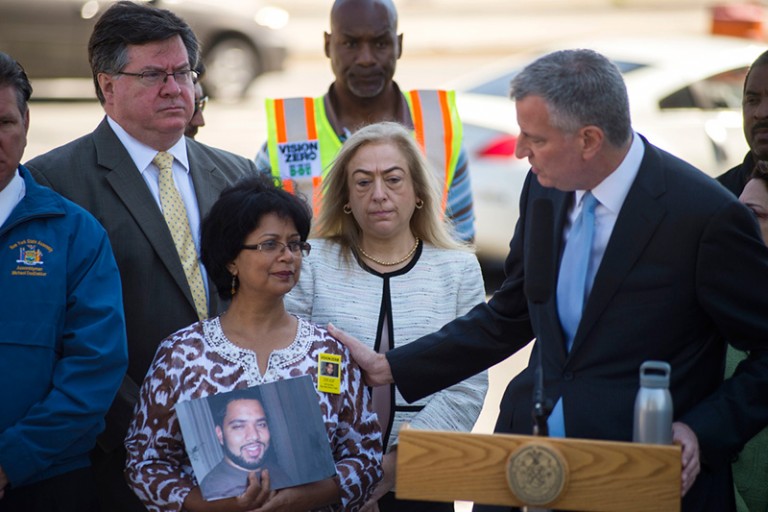PHOTO: Photo Courtesy of the Mayor’s Office
Year-round, south Queens sees its fair share of vehicular accidents on highways and residential streets alike. Nationwide, approximately 40,000 deaths from car accidents occur each year, speed accounting for a majority of those, while drunk driving and no seatbelts worn are other reasons. According to the National Highway Traffic Safety Administration, blizzard conditions in January have nothing, statistically speaking, on good-weather, summertime driving and the numbers of accidents that occur during this season. Most car accidents happen at night, most on Saturdays, and most, interestingly enough, happen during the month of August. We get out more when the weather’s nice, and that means more cars on the road and more pedestrians (and children) on the sidewalks.
Last week, Mayor de Blasio announced that Phase 1 of a $100 million construction project announced earlier this year as part of Vision Zero has begun on Queens Boulevard, a “priority corridor” in the project. Since 1990, 185 New Yorkers have died on the boulevard. Between 2009 and 2013 alone, six people were killed and over 600 injured (36 of them severely) on the 1.3 mile stretch that Phase 1 covers. The project includes a number of major improvements, including bike lanes, safer crossings, pedestrian ramps and refuges, and the reorganization of service roads. Nicknamed the “Boulevard of Death” by the New York Daily News, de Blasio referenced the new “Boulevard of Life” in his announcement. For pedestrians, it’s true that Vision Zero appears to be working. Last year, the inaugural one, was the safest for pedestrians “since record-keeping began in 1910,” according to the Mayor’s website.
This past weekend, a hit-and-run occurred in Lindenwood near a “high-risk” intersection that local elected officials and civics have been fighting to get attended to for years. The Department of Transportation is currently studying that and other nearby intersections, which Assemblyman Phil Goldfeder called “confusing,” particularly for the area’s large senior population. It was Goldfeder who requested the DOT study, set to be completed in the next few weeks. It’s a shame another accident happened before that study could conclude and improvements be made. Meanwhile, the Department has begun implementing “daylighting” in the Lindenwood area – which means removing parking spots near intersections to increase visibility for drivers.
As we head into peak accident season, these imminent improvements are good news for our community. But we need to do more. We could use more daylighting in the area — for one example, on 156th Avenue in Old Howard. Turning left onto the avenue from 97th Street, a car often has to push out into the street almost a full car length to get a view of cars coming from either side. We could get rid of or fix the intermittently-flashing light cameras at Pitkin and Cross Bay, which seem to go off with no rhyme or reason, regardless of whether a car has missed the red light or not. It’s a distraction for drivers, at least. Woodhaven Boulevard is getting Select Bus Service (eventually), its design still underway. Benefits will include safer streets and medians, and improved traffic flow. $100 million for improvements to Queens Boulevard seems like a drop in the bucket – and comes not a moment too soon. What can you to protect yourself during this dangerous driving time? Let your representatives know if you’re aware of problem areas, never drink impaired or tired, avoid driving at night, and above all, always remember your seatbelts.

